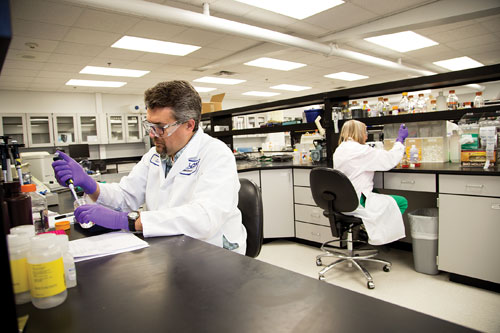October 1, 2015 (Vol. 35, No. 17)
Imaging Platform Provider Shines by Advancing Near-IR and Chemiluminescence Detection
LI-COR Biosciences, a 44-year old biotech hardware, software, and consumables company, grew out of an agronomy project, the development of light measurement devices for the study of photosynthesis. Besides putting down roots in plant science, LI-COR branched out, pursuing opportunities in environmental science and, eventually, biotechnology. In 1992, LI-COR developed an automated DNA sequencer. A year later, the company’s instrumentation was setting global standards for read lengths and accuracy.
LI-COR has since parlayed its role as an instrumentation pioneer for the human genome project into cutting-edge imaging techniques for protein visualization, small animal in vivo imaging, imaging-guided surgery, and potential therapeutic applications.
LI-COR’s biotechnology-related work, like its plant science and environmental work, measures biological parameters based on the interaction between electromagnetic radiation and physical matter. The biotechnology work, however, is distinct, in that it relies on infrared dye detection.
“The dyes we developed for gene sequencing demonstrated the unique advantages of infrared fluorescence imaging,” asserts D. Doc Chaves, LI-COR’s director of corporate communications. “Today, using infrared dyes and imaging technology is a proven method of providing consistent, quantitative data for immunoblotting and a host of other applications.”
“Researchers have helped move the technology forward,” he continues, by demonstrating that it offers clear advantages for in vivo imaging, new avenues for imaging-guided surgery, and promising potential for photoimmunotherapy.”
New Dye Technology
Aspyrian Therapeutics filed an IND with the FDA last spring for a photoimmunotherapy platform using LI-COR’s IRDye® 700DX. The platform precisely targets recurrent head and neck cancers. The dye is activated by near-infrared light and destroys the tumors without damaging surrounding tissues.
Additional clinical trials underway using LI-COR infrared dye technology include imaging-guided surgery for breast cancer, brain cancer, and rectal cancer. Aura Biosciences recently announced a clinical trial targeting rare ocular cancers using its technology in conjunction with a LI-COR infrared dye.
Advances in dye technology are central to a growing range of research capabilities throughout the biomedical industry. Last spring, LI-COR teamed with MitoSciences to develop quantitative near-infrared fluorescence imaging assays using LI-COR’s IRDye fluorescent dye-labeled secondary antibodies. This collaboration led to MitoSciences’ In-Cell ELISA (ICE) assay kits. These kits, MitoSciences insists, deliver reproducible, high-throughput, highly sensitive quantitative data for disease and metabolic pathway research.
Those ICE Assay kits are designed to be imaged with LI-COR’s Odyssey® Infrared Imaging System. The assays monitor stress-induced, species-variant, or tissue-specific changes or differences in mitochondrial and other metabolic targets.

LI-COR manufactures hardware, analysis software, and consumables, including its unqiue IRDye family of infrared dyes.
Imaging
LI-COR says it has positioned itself as a complete Western blot solution provider. After an initial focus on building its Odyssey Clx platform as a standard detection tool with infrared fluorescence, the company expanded its technologies for chemiluminescence imaging, a mainstay technique for Western blots.
“We expanded our product line to include the Odyssey Fc dual-mode western imager,” informs Jim Wiley, director of marketing for LI-COR’s biotech product line. “It combines infrared and chemiluminescence technologies, so it’s perfect for customers who have optimized their labs with chemiluminescence, and gives them the option to do quantitative work using infrared.”
One of LI-COR’s newest instruments is the Pearl® Trilogy, a small-animal preclinical imager. “Bioluminescence imaging has become a mainstay for drug development to enable researchers to look at the tumor burden,” observes Wiley. “Pearl Trilogy enables scientists to look at biodistribution as well as the overall tumor burden.”
The Pearl Trilogy builds upon the original Pearl, which was introduced as a two-channel infrared fluorescence imager. “A bioluminescence channel adds versatility and functionality,” asserts Wiley, who points out that is part of LI-COR’s mission to build high-value, low-cost instruments.
Another new instrument is LI-COR’s recently introduced C-DiGit® Blot Scanner, which reads only chemiluminescent blots. “It’s a very small and very personal scanner,” Wiley tells GEN. “Its footprint is smaller than a laptop. It is a fraction of the price of high-end charge-coupled devices (CCDs), but provides comparable performance.”
As a digital scanner, the C-Digit eliminates the need for film. “It also offers reduced costs, better data, and greater convenience,” Wiley elaborates. “Many institutions are closing down their darkrooms to lower costs and reduce their environmental impact.”
Strategic Growth
LI-COR’s growth strategy is based upon developing innovative solutions that address modern, unmet customer needs. “The industry shares a goal to improve productivity and at the same time lower costs,” explains Wiley, “so we are continuing to develop our high-value, low-cost concept for hardware, software, and reagents.”
Increasing reproducibility of experiments within the scientific community is another concern for LI-COR, which is actively engaged with the Reproducibility Initiative. The National Institutes of Health (NIH) is concerned that a significant percentage of research can’t be reproduced, Wiley says. While the reasons vary, including differing lab environments and subtle changes in protocols, the NIH is partnering with researchers and companies to help ensure higher quality, more reproducible data.
“Our imaging systems are well suited for providing reproducible data due to their large dynamic range,” Wiley states. “Infrared provides better data compared to other detection methods.” But, he adds, hardware is only part of the solution.
The Reproducibility Initiative aims to reduce the problem of experiments that can’t be replicated by other laboratories or even by other researchers in the same laboratory. As a result of this project and LI-COR’s partnership with AntibodiesOnline.com, “We have a list of infrared fluorescent-labeled antibody products that have earned the Initiative’s ‘Reproducibility stamp,’” Wiley declares. AntibodiesOnline.com is working with third-party validators to increase the transparency of product quality.
LI-COR Biosciences



